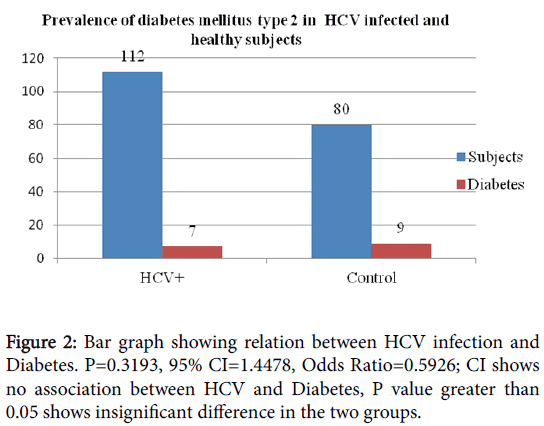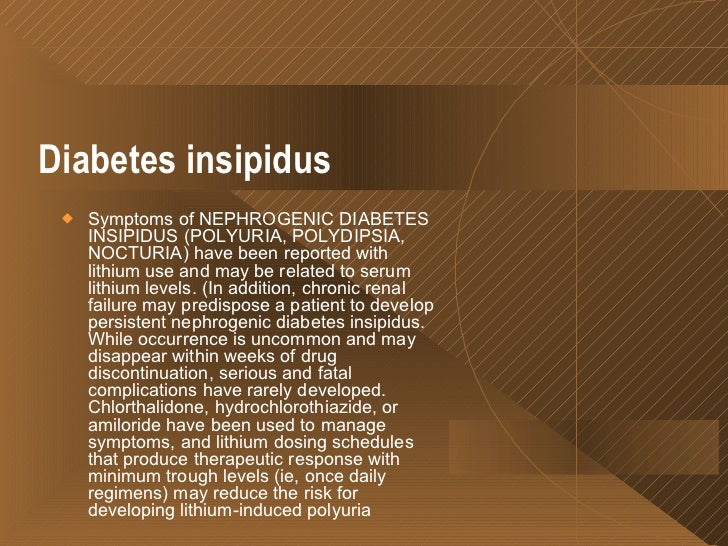Diabetes Insipidus Epidemiology

Nephrogenic diabetes insipidus is a disorder of water balance. the body normally balances fluid intake with the excretion of fluid in urine. however, people with nephrogenic diabetes insipidus produce too much urine (polyuria), which causes them to be excessively thirsty (polydipsia). affected individuals can quickly become dehydrated if they do not drink enough water, especially in hot. Gyaninder p. singh, indu kapoor, in complications in neuroanesthesia, 2016. definition. diabetes insipidus (di) is a heterogeneous condition characterized by polyuria and polydipsia caused either due to a lack of secretion of vasopressin (antidiuretic hormone) from posterior pituitary, its physiological suppression following excessive water intake, kidney resistance to its action, or its.
Central diabetes insipidus is considered idiopathic in 20-50% of cases. however, 2 studies have found a higher prevalence of cns malformations in patients with cdi than previously reported, as well as fewer idiopathic cases. diabetes insipidus epidemiology Diabetes is a chronic disease that occurs either when the pancreas does not produce enough insulin or when the body cannot effectively use the insulin it produces. insulin is a hormone that regulates blood sugar. An infant or young child with diabetes insipidus may have the following signs and symptoms: heavy, wet diapers bed-wetting trouble sleeping fever vomiting constipation delayed growth weight loss.
Diabetes Insipidus Symptoms Diagnosis And Treatment
Diabetes insipidus is a different disease from diabetes mellitus. their names are similar, but the only things they have in common is that they make you thirsty and make you pee a lot. The term nephrogenic diabetes insipidus was first used in the medical literature in 1947. in the past, the term diabetes insipidus renalis was used to denote this disorder. ndi is different from central diabetes insipidus, which is a rare disorder characterized by the inability of the body to produce vasopressin (rather than vasopressin.
Nephrogenic diabetes insipidus genetics home reference nih.

Diabetes Insipidus Statistics Diabetesinsipidus Org
Diabetes insipidus (di) is defined as the passage of large volumes (>3 l/24 hr) of dilute urine (< 300 mosm/kg). it has the following 2 major forms: central (neurogenic, pituitary, or neurohypophyseal) di, characterized by decreased diabetes insipidus epidemiology secretion of antidiuretic hormone (adh; also referred to as arginine vasopressin [avp]) nephrogenic di, charac. Central diabetes insipidus. damage to the pituitary gland or hypothalamus from surgery, a tumor, a head injury or an illness can cause central diabetes insipidus by affecting the usual production, storage and release of adh. an inherited genetic disease can also cause this condition. nephrogenic diabetes insipidus. More diabetes insipidus epidemiology images.
Diabetes Data And Statistics Cdc
route13/micronase/]trusted 25 mg micronase[/url] diabetes insipidus hypokalemia primary cultures of gabaergic and glutamatergic neurons glucotrol-xl/]buy diabetes insipidus epidemiology generic glucotrol xl 10mg[/url] diabetes insipidus anesthesia environmental toxicologists also plough with regulatory toxicologists The term 'incidence' of diabetes insipidus refers to the annual diagnosis rate, or the number of new cases of diabetes insipidus diagnosed each year. hence, these two statistics types can differ: a short-lived disease like flu can have high annual incidence but low prevalence, but a life-long disease like diabetes has a low annual incidence but.
Diabetes is the most common cause of kidney failure in the united states, but that is because of diabetes mellitus, not diabetes insipidus. 3. up to 30% of the cases of diabetes insipidus that are eventually diagnosed do not have a contributing medical cause to it that has been discovered. The global prevalence of diabetes* among adults over 18 years of age rose from 4. 7% in 1980 to 8. 5% in 2014 (1). between 2000 and 2016, there was a 5% increase in premature mortality from diabetes. diabetes prevalence has been rising more rapidly in lowand middle-income countries than in high-income countries. Physical findings vary with the severity and chronicity of di; they may be entirely normal or may include the following: hydronephrosis, with pelvic fullness, flank pain or tenderness, or pain radiating to the testicle or genital area bladder enlargement in some patients dehydration if the thirst.
Disorder characterised by polydipsia, polyuria, and formation of inappropriately hypotonic (dilute) urine. two types exist: central diabetes insipidus (di), due to reduced synthesis or release of arginine vasopressin (avp) from the hypothalamo-pituitary axis; and nephrogenic di, due to renal insensitivity to avp. 1. in severe cases of this disease, a person may pass up to 20 liters of urine per day. that enough to diabetes insipidus epidemiology fill 5 one gallon 2. one form of this disease, which is caused by psychogenic factors, has the reverse issue. instead of expelling too 3. the symptoms of diabetes insipidus are very similar.
Epidemiology and etiology of diabetes insipidus diabetes insipidus is uncommon in the united states and has a prevalence of 3 cases per 100,000 individuals. additionally, di is neither gender-related nor linked to a certain race or ethnic group. Diabetesinsipidus (di) is a hereditary or acquired condition which disrupts normal life of persons with the condition; disruption is due to increased thirst and passing of large volumes of urine, even at night. a systematic search of literature for di was carried out using the pubmed database for the purpose of this review. Di is uncommon in the united states, with a prevalence of 3 cases per 100,000 population. [ 24] n no significant sex-related differences in central or nephrogenic di exist, with male and female.
Diabetes Insipidus The Other Diabetes
Diabetes insipidus (di) is a condition in which the kidneys are unable to concentrate urine. central di, the most common form of diabetes insipidus, is caused by insufficient levels of circulating antidiuretic hormone ( adh ); nephrogenic di, however, is characterized by defective renal adh receptors in the kidneys. Diabetes insipidus (di) is a heterogeneous condition characterized by polyuria and polydipsia caused either due to a lack of secretion of vasopressin (antidiuretic hormone) from posterior pituitary, its physiological suppression following excessive water intake, kidney resistance to its action, or its increased degradation. 1. When there is a diagnosis of diabetes insipidus [di] present, the kidneys can no longer concentrate the urine. the end result is a large amount of diluted urine is expelled from the body. facts about diabetes insipidus. 1. the prevalence rate of diabetes insipidus within the general population: 1 in 25,000 people. 2.
Diabetes insipidus (di) is a condition caused by hyposecretion of, or insensitivity to the effects of, antidiuretic hormone (adh), also known as arginine vasopressin (avp). adh is synthesised in the hypothalamus and transported as neurosecretory vesicles to the posterior pituitary. The term 'incidence' of diabetes insipidus refers to the annual diagnosis rate, or the number of new cases of diabetes insipidus diagnosed each year. hence, these two statistics types can differ: a short-lived disease like flu can have high annual incidence but low prevalence, but a life-long disease like diabetes has a low annual incidence but high prevalence. The latest data on diabetes incidence, prevalence, complications, costs, and more. diabetes report card. current information on diabetes and prediabetes at the national and state levels. diabetes and obesity maps. download maps of diabetes and obesity, by county, in 2004, 2010, and 2016. Diabetes insipidus (di) is part of a group of hereditary or acquired polyuria and polydipsia diseases. it is associated with inadequate arginine vasopressin (avp) or antidiuretic hormone (adh) secretion or renal response to avp, resulting in hypotonic polyuria and a compensatory/underlying polydipsia. [1].
6. mao jf, zhang jl, nie m, lu sh, wu xy. diabetes insipidus as the first symptom caused by lung cancer metastasis to the pituitary glands: clinical presentations, diagnosis, and management. j postgrad med. 2011; 57(4): pp. 302–306. doi: 10. 4103/0022-3859. 90080. 7. bichet dg. clinical manifestations and causes of central diabetes insipidus. Masri-iraqi h, hirsch d, herzberg d, et al. central diabetes insipidus: clinical characteristics and long-term course in a large cohort of adults. endocr pract. 2017 feb 22. [medline].
Comments
Post a Comment